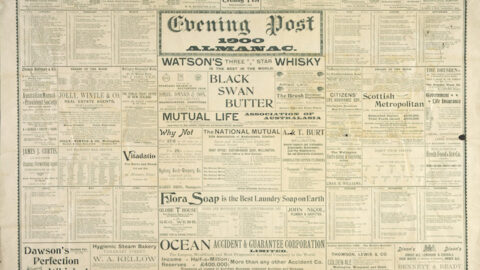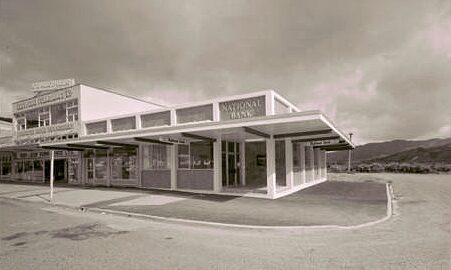The Damage to the Wainui Waterworks – The Engineer’s Report
The Acting City Engineer, Mr J. D. Baird, returned last evening from his visit of inspection to the waterworks at Wainui-o-mata, where, as we mentioned yesterday, such serious damage was done by the great flood on Tuesday last, resulting from the unprecedented rainstorm of the previous day. It appears that the river rose rapidly and steadily during Monday night, and attained its greatest height on Tuesday morning, remaining at that point for about five hours, when it gradually receded, having meanwhile done all the mischief, which will take at least four months to repair.
It will be recollected that on two former occasions extensive injury and delay was caused to the work by exceptionally severe floods, but this has been by far the worst of all and the more unlucky, inasmuch as it has occurred when the work had been absolutely completed for nearly a week, although the contractor, Mr Bayliss, was still responsible for its maintenance in good order until two months should have elapsed from the date of completion. It will be seen from what follows that there is some doubt as to the interpretation of this provision in the contract.
Mr Baird states that the contract was finally completed last Wednesday evening, and it only remained for the wet cement to have time to dry and consolidate for the work to be thoroughly durable and able to defy all the attacks of storm and flood. Unluckily, this necessary respite was not granted. The concluding piece of work done was to fill in the “grouting” of one corner, which had to be left until the last in order that the carts conveying sand and other materials might have room to turn.
It may be explained that the space between the upper retaining wall of the dam, about 26 feet high, against which the weight of the water rests, and the lower wall at the foot of the dam is filled in with rubble, and above all is a covering of stone boulders laid in concrete and filled with grouting – or thin mortar – so that the whole when dry would form a solid external facing. The dam was, in fact, paved with boulders on two feet of cement, all crevices being filled in, as above described, with liquid cement.
The work was finally passed by Mr Baird on Thursday, and was duly taken over by the Corporation, the concluding payments being made, a custodian placed in charge of the reservoir, and the water turned into the city mains. The work appears to have stood all right when the flood had materially exceeded the normal height of floods. But after a time, when the water had attained a height of 11 feet over the dam, and this enormous volume was rushing down with the full force of an overflow, the structure began to give way.
There is a difference of opinion as to the manner in which the first inroad was effected by the flood. One theory is that the last finished portion of cement work, being still “green” or slightly soft owing to incomplete consolidation, succumbed to the excessive scour, and allowed the first breach to be made in the work. It is asserted, however, on the other hand, that the cement, even if not quite set, would not have given way to the direct attack of the water, and that it only yielded through being assailed in the rear, as it were, owing to the flood being so excessive as to rise over all the cement protected parts and to get at the ordinary unprotected soil. This it swiftly cut away, and thus obtaining a point of advantage from which to attack the dam-filling, tore and scoured and swept it away in detail, boulder by boulder, until nothing but the two retaining walls, upper and lower, were left standing. Whatever the immediate cause, that was what happened. Everything but the walls is swept away.
Unfortunately this is not the full sum of the mischief. A temporary channel had been cut, by the contractor, through a neck of land, to serve as an overflow while the work was under construction. This overflow channel was about 7ft deep and 5ft wide. On the dam being finished the temporary channel was filled in by the contractor and closed at its entrance with concrete. But here again the extraordinary height of the flood enabled the water to find access to the side and back of the channel. A way once made, the rest was easy.
All the filling was swept out, and, more than this, a new channel, no less than 30ft wide and 25ft deep, was actually cut by the torrent through the solid rocky natural formation. The workmen’s huts very narrowly escaped being washed away by the irresistible torrent, and they were saved only just in time. The consequence is that this new river will have to be dammed up, as well as the regular dam being repaired, before the water service can be renewed. It is possible means may be found to utilize it partially by inserting, before filling up the chasm, an extra relief tunnel for flushing the bottom or in case of future floods. This, however, will be an expensive affair, as indeed will all the requisite repairs. The cost is at present estimated at about £2000, and the time required at about four months, even should no other flood intervene to enhance the difficulty.
The mishap has been most unfortunate, upon whomever the loss may fall. We understand there is some doubt as to the extent to which the contractor’s liability to two months’ maintenance applies to such a case as this in which the damage is due to a flood of such abnormal and unforeseen height. We believe the City Engineer holds the liability to include responsibility for making good any damage that may occur within the two months limit, but that the contractor and his advisers contend he is not responsible, because on the engineer’s own certificate the work was delivered to the Corporation in good order, and finally completed according to the drawings and specifications, from which he was not at liberty to depart, even had he deemed such departure necessary for the safety of the work.
Either way, the affair will be a very awkward one for all concerned. Mr N. Marchant, C.E., has gone out to Wainui-o-mata this afternoon to inspect the work and damage, and the City Council meets to-day to consider the situation.
Tags: Floods Newspaper Tunnels Waterworks




